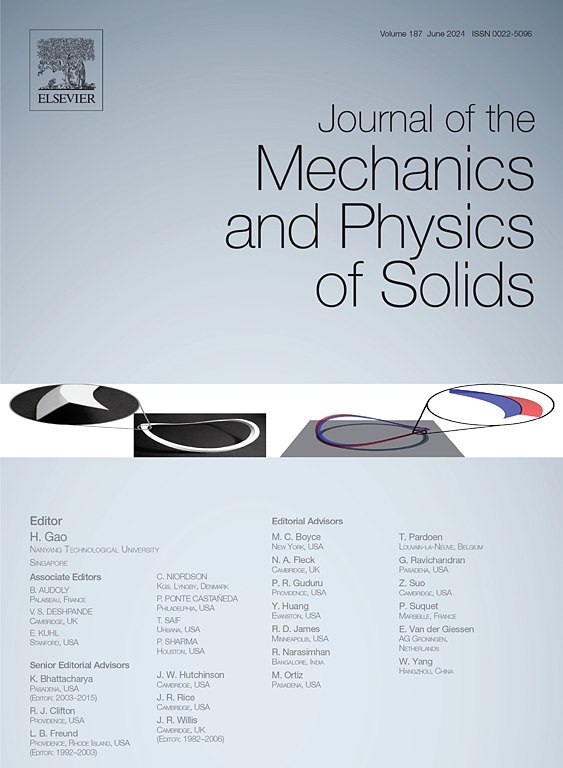Coupled magneto-mechanical growth in hyperelastic materials: Surface patterns modulation and shape control in bio-inspired structures
IF 5
2区 工程技术
Q2 MATERIALS SCIENCE, MULTIDISCIPLINARY
引用次数: 0
Abstract
Magneto-mechanical coupling in the growth of soft materials presents challenges due to the complex interactions between magnetic fields, mechanical forces, and growth-induced deformations. While growth modeling has been extensively studied, integrating magnetic stimuli into growth processes remains underexplored. In this work, we develop a 3D governing system for capturing the coupled magneto-mechanical growth behaviors of soft materials. Based on the governing system, we propose a finite element framework, where the robustness and accuracy of the proposed framework are demonstrated through numerical simulations, including the uniaxial loading of a circular tube, a mesh convergence study, and surface pattern evolution. We also conduct experiments on surface pattern modulation in magneto-active soft materials. Specifically, we fabricate film–substrate samples and apply growth-induced instabilities combined with external magnetic fields to generate tunable surface patterns. To demonstrate the capabilities of our method, we apply our numerical framework to mimic the biological morphogenesis, such as the inversion process of the algal genus Volvox. Our study shows that integrating magneto-mechanical coupling with growth effects allows for flexible control over surface patterns, significantly enhancing the adaptability and responsiveness of soft materials. This work paves the way for innovative designs of adaptive and programmable soft materials, with potential applications in soft robotics, biomimetic structures, and tissue engineering.
超弹性材料的磁-机械耦合生长:仿生结构中的表面模式调制和形状控制
由于磁场、机械力和生长引起的变形之间的复杂相互作用,软材料生长中的磁-机械耦合提出了挑战。虽然生长模型已被广泛研究,但将磁刺激整合到生长过程中仍未得到充分探索。在这项工作中,我们开发了一个三维控制系统来捕捉软材料的磁-机械耦合生长行为。基于控制系统,我们提出了一个有限元框架,其中所提出的框架的鲁棒性和准确性通过数值模拟来证明,包括圆管的单轴载荷,网格收敛研究和表面图案演变。我们还进行了磁活性软材料的表面模式调制实验。具体来说,我们制造薄膜衬底样品,并应用生长诱导的不稳定性与外部磁场相结合来产生可调谐的表面图案。为了证明我们的方法的能力,我们应用我们的数值框架来模拟生物形态发生,例如藻类属Volvox的反转过程。我们的研究表明,将磁-机械耦合与生长效应相结合,可以灵活地控制表面图案,显著提高软材料的适应性和响应性。这项工作为自适应和可编程软材料的创新设计铺平了道路,在软机器人、仿生结构和组织工程方面具有潜在的应用前景。
本文章由计算机程序翻译,如有差异,请以英文原文为准。
求助全文
约1分钟内获得全文
求助全文
来源期刊
CiteScore
9.80
自引率
9.40%
发文量
276
审稿时长
52 days
期刊介绍:
The aim of Journal of The Mechanics and Physics of Solids is to publish research of the highest quality and of lasting significance on the mechanics of solids. The scope is broad, from fundamental concepts in mechanics to the analysis of novel phenomena and applications. Solids are interpreted broadly to include both hard and soft materials as well as natural and synthetic structures. The approach can be theoretical, experimental or computational.This research activity sits within engineering science and the allied areas of applied mathematics, materials science, bio-mechanics, applied physics, and geophysics.
The Journal was founded in 1952 by Rodney Hill, who was its Editor-in-Chief until 1968. The topics of interest to the Journal evolve with developments in the subject but its basic ethos remains the same: to publish research of the highest quality relating to the mechanics of solids. Thus, emphasis is placed on the development of fundamental concepts of mechanics and novel applications of these concepts based on theoretical, experimental or computational approaches, drawing upon the various branches of engineering science and the allied areas within applied mathematics, materials science, structural engineering, applied physics, and geophysics.
The main purpose of the Journal is to foster scientific understanding of the processes of deformation and mechanical failure of all solid materials, both technological and natural, and the connections between these processes and their underlying physical mechanisms. In this sense, the content of the Journal should reflect the current state of the discipline in analysis, experimental observation, and numerical simulation. In the interest of achieving this goal, authors are encouraged to consider the significance of their contributions for the field of mechanics and the implications of their results, in addition to describing the details of their work.

 求助内容:
求助内容: 应助结果提醒方式:
应助结果提醒方式:


